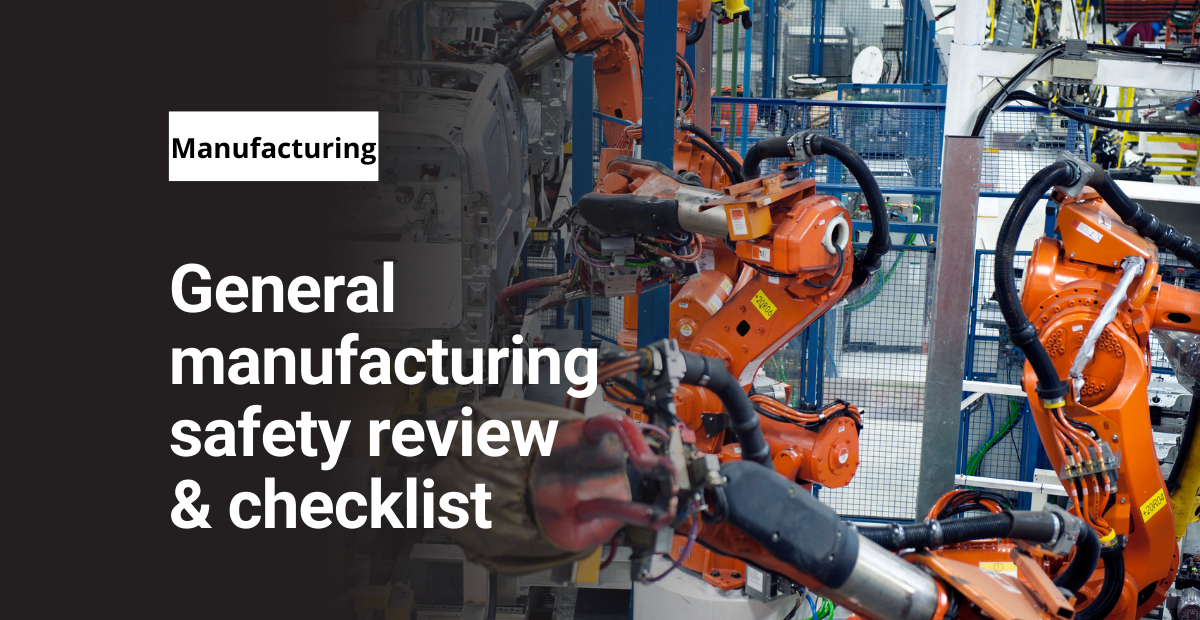To control safety hazards, you have to perform a routine manufacturing safety review. This involves considering the risks in each work area and implementing control measures. Below are factors that you should consider when conducting your reviews.
Free checklist!
Use this simple checklist during your manufacturing safety review to determine the severity and types of hazards within your facility.
Securing the manufacturing environment, a safety review
The NFPA 101 Life Safety Code covers specific requirements for stairways, exits, and doors. During a safety review, these requirements can help with assessing limits of hazards.
- Handrails for stairs should be 30 to 34 inches above the tread surface.
- Doors that open onto a passageway pose a hazard to oncoming traffic. Use guardrails to minimize or paint the floor to mark the swing area.
- Keep exits unobstructed and well illuminated. Also, use emergency lighting in exit hallways or paths. Inadequate illumination due to glares or shadows can contribute to accidents.
- Illumination levels should remain consistent to reduce visual fatigue.
- The manufacturing layout should not require employees to face windows, unshielded lamps, or other sources of glare.
Ways to reduce electrical hazards
Here are a few tips for reducing the safety risks that come with electrical components in your manufacturing facility:
- Arrange electrical extension cords to avoid tripping hazards, a key point in manufacturing safety reviews.
- Install proper receptacles.
- Likewise do not substitute permanent wiring with electrical extension cords.
- Place a label on each fuse or circuit breaker switch and a corresponding label on each receptacle and light switch.
Of course, you should also train your employees on the various electrical hazards they may come across.
Addressing hazards on the manufacturing floor
Here are some tips you should consider if you find a lot of hazards during your manufacturing safety review, which should strive to address all potential risks:
- Floor surfaces should have a slip-resistant finish. Additionally, minimize tripping hazards by immediately replacing defective tiles and carpet or worn floor mats. Slip-resistant floor wax can give polished floors a higher coefficient of friction.
- Floor mats and runners offer more slip-resistant protection for stairways or lobby entrances. Offices should have an area specifically designed for storing supplies.
- Stack materials neatly in stable piles with the heaviest pieces on the bottom.
- Do not place manufacturing equipment on the edge of a table or desk.
- The most common manufacturing accident is falling. Slips, trips, and falls can result from poor housekeeping such as wet surfaces, electrical cords improperly placed, and trash obstructed walkways.
Manufacturing safety procedures review
The importance of a manufacturing safety review cannot be overstated, as following safe work procedures in manufacturing can prevent many accidents.
- Running in offices must be prohibited. Those walking in a passageway should keep to the right. Employees should stand away from the path of the door swing.
- Employees should not attempt to carry stacks of materials that are high enough to obstruct vision. If an elevator is available, it should be used instead of carrying stacks of material up flights of stairs.
- Spilled liquids should be cleaned up immediately, and broken glass should be removed when first noticed. Be sure to use cleaning materials with care.
- Other unsafe manufacturing procedures include storing pencils with the points upward, placing scissors or knives with the point toward the user, using paper cutters without proper guards, and placing glass objects on a desk or table edge.




